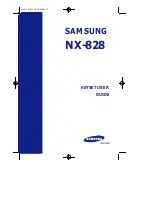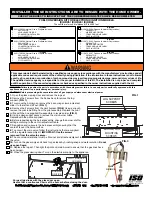
WARNING
POSITION THE BLOWER ASSEMBLY AND BREATHING TUBE TO PERMIT A FULL
RANGE OF MOVEMENT BY THE USER WITHOUT PRESENTING A HAZARD OF SNAG-
GING OR TANGLING. HAVING THE BREATHING TUBE EXCESSIVELY LOOSE OR
EXCESSIVELY TIGHT MAY RESULT IN THE FACEPIECE BEING PULLED FROM THE
USER’S FACE EXPOSING THE USER TO THE HAZARDOUS ATMOSPHERE THE RES-
PIRATOR WAS INTENDED TO PROTECT AGAINST WHICH MAY RESULT IN SERIOUS
INJURY OR DEATH.
WARNING
FAILURE TO PERFORM A SATISFACTORY NEGATIVE PRESSURE LEAK CHECK MAY
RESULT IN LITTLE OR NO RESPIRATORY PROTECTION AND MAY EXPOSE THE
WEARER TO SUBSTANCES THAT CAN CAUSE SERIOUS INJURY OR DEATH.
FIGURE 7
10
10. Additional protective clothing and protective head wear, if used, must be arranged so
that it does not interfere with the fit of the facepiece or restrict the air flow to the air
filtration elements.
11. The blower assembly and breathing tube must be arranged so that:
a)
There is enough slack in the breathing tube so the respirator user can turn his
head through a full range of motion without the breathing tube pulling on the
facepiece, the breathing tube being pinched closed or the breathing tube inter-
fering with other protective clothing or equipment.
b)
The blower assembly and breathing tube must not be positioned so that exces-
sive slack of the breathing tube is likely to catch on objects.
8.
PERFORM NEGATIVE PRESSURE LEAK CHECK
as follows:
NOTE
WHEN PERFORMING LEAK CHECK, TEMPORARILY POSITION THE BLOWER ASSEMBLY
AT THE FRONT OF THE WAIST TO ASSIST IN SEALING AIR FILTRATION ELEMENT INLETS.
a)
With the blower assembly turned OFF, close off inlet side of
both
air filtration
BREATHING TUBE AND/OR AIR FILTRATION ELEMENT CONNECTIONS, A DAMAGED
OR MISSING EXHALATION VALVE OR OTHER DAMAGED RESPIRATOR COMPO-
NENTS. DO NOT USE A DAMAGED OR LEAKING RESPIRATOR. MAKE REPAIRS AND
RECHECK RESPIRATOR OR REMOVE RESPIRATOR FROM SERVICE AND TAG IT FOR
REPAIR BY AUTHORIZED PERSONNEL.
elements by placing palms of hands or
other airtight objects over the inlets of
the air filtration elements. Press firmly to
seal the inlets. See FIGURE 7.
b)
Inhale slowly and hold breath momen-
tarily.
c)
Leakage shall not be present and the
facepiece shall be drawn slightly to the
face.
9.
If leakage of air is detected during the above
procedure, doff (remove) the facepiece and
re-don the facepiece according to Step 7
above. If leakage persists, DO NOT USE THE
RESPIRATOR.
NOTE
IN ADDITION TO A POOR FACEPIECE FIT, LEAK-
AGE MAY BE THE RESULT OF LOOSE
BREATHING TUBE CONNECTION, IMPROPERLY
TIGHTENED AIR FILTRATION ELEMENTS, DAM-
AGED OR MISSING GASKETS AT THE
The SCOTT PROFLOW 2 respirator is now donned and in standby mode.
Summary of Contents for 2
Page 21: ...NOTES 20 ...








































